Deck F-8 Crusader, its predecessors and descendants (Part of 3)
In the late 50s, the main strike force of the deck assault squadrons were the A-1 Skyraider and A-4 Skyhawk. Piston "Skyrader" was ideally suited for fighting partisans, cleaning the area when landing, and escorting helicopters. But in the era of jet aviation this reliable and tenacious aircraft with an air-cooled piston engine was an anachronism, and its withdrawal from the carrier wings was a matter of the next decade.
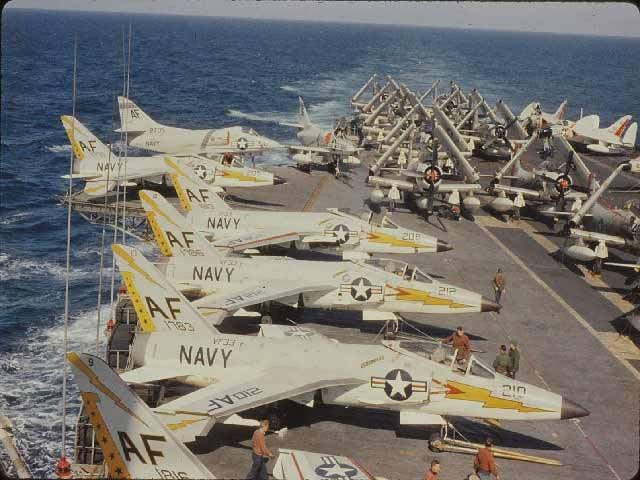
Typical composition of the 50's end of the aircraft carrier wing: F11F Tiger fighter jets in the foreground, followed by A-1 Skyraider and A-4 Skyhawk fighter planes
The Skyhawk was in many ways a very successful car. Among its advantages were small geometric dimensions and weight, which facilitated placement on an aircraft carrier, a simple, robust design and ease of control. The sufficiently high flight data of the A-4 made it possible to successfully conduct a defensive air battle with fighters. The А-4 Skyhawk, which had the A1962D index until 4, could fight almost on equal terms with the MiG-17F fighters without bombs. At the same time, the attack aircraft had good takeoff and landing characteristics, which was important when basing on an aircraft carrier or short-range ground runways. The A-4E modification aircraft with a Pratt & Whitney J52-P-6A engine with a nominal thrust of 38 kN, without bomb load, developed a maximum speed at the ground of 1083 km / h, and was able to maneuver with an operational overload of 8 G - that is, its flight data was at the level of the FJ4 Fury fighter.
At the start of the 60, the A-4 attack aircraft cost the US Air Force $ 860 000, which was about three times less than the price of the F-4 Phantom II. But at the same time, for all its merits, the deck Skyhawks with a maximum take-off weight of about 10 000 kg could carry a combat load of no more than 3700 kg and had a rather modest combat radius of about 450 km.
Despite the fact that the A-4 did not fully satisfy the American admirals in terms of flight range and payload, its good performance and operational characteristics and a good price-quality ratio ensured the attack aircraft a long life. From 1954 to 1978, McDonnell Douglas built 2 960 aircraft of this type.
Operation of the A-4 on aircraft carriers continued until 1975. The Marine Corps held on to them until 1998. However, the last two-seat TA-4Js have been removed from service with training naval squadrons only in 2003. In addition to the US Navy markings, these vehicles were marked with red stars, and they were used during exercises to simulate enemy aircraft.
Deck bomber A-3 Skywarrior (up to 1962, A3D), originally created as a carrier of nuclear weapons, was built quite limited by the standards of the 50-s series (282 aircraft). The aircraft with a maximum take-off weight of 31 750 kg was too large and heavy to be based on aircraft carriers. Skywatch could take up to 5 800 kg of combat load in the form of 227-908 kg of aerial bombs, and at the initial stage of the war in Southeast Asia was used to apply massive air strikes and mine.
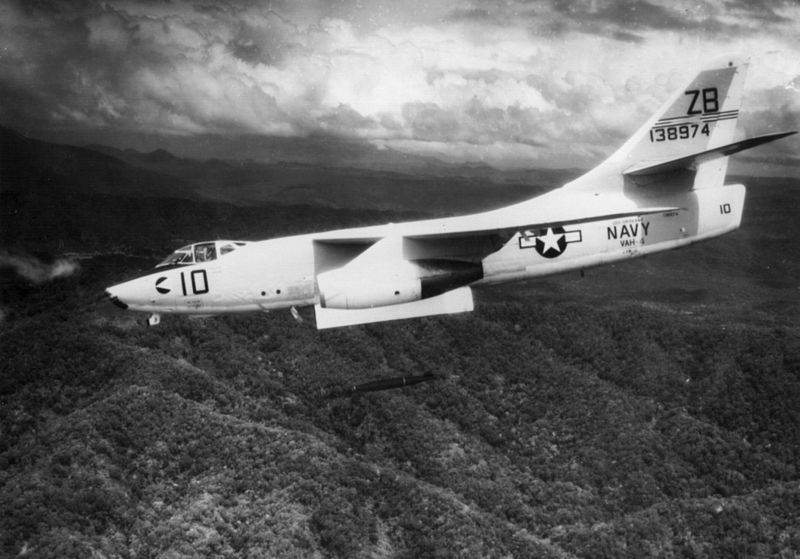
The adoption of the Polaris strategic system has devalued the value of A-3 bombers as a carrier of nuclear weapons, and the aircraft proved to be too complicated and expensive to maintain to carry out routine bombardments in Vietnam. The technical readiness ratio of the SkyWatch was significantly worse than that of other carrier-based aircraft. In addition, a large and heavy machine with an 3G operating overload and a maximum flight speed of 1007 km / h was too vulnerable for enemy fighters and the CA-75M Dvina SAM system.
After adopting the supersonic deck bombers A-5A Vigilante, the slow A-3s were converted into reconnaissance aircraft RA-3B, jammers EA-3В and air tankers EKA-3B, on board which also had EW equipment. These modifications were used in combat operations in Southeast Asia, providing support for other carrier-based aircraft. Intelligence options were actively used over South Vietnam, where they tracked camps and movement routes of partisans with the help of infrared cameras at night.
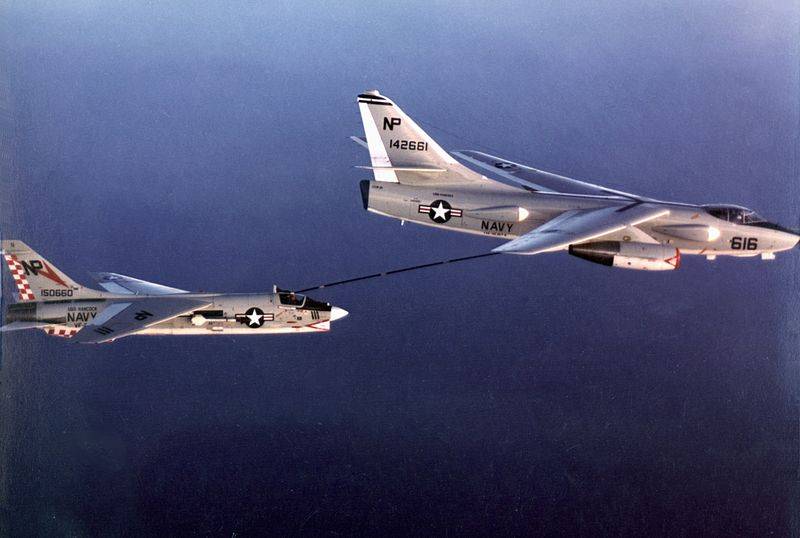
Although the plane as a deck bomber was quickly outdated, due to the large margin of safety, the active exploitation of the Skywright in the version of the jammer-jammer continued until the beginning of the 90-s.
The A-3 Skywarrior was to be replaced by the A-5 Vigilante supersonic bomber (A1962J-3 before 1). The operation of this largely outstanding aircraft began in the 1962 year. The twin “Widget” was a very high-tech aircraft for its time, in which the most advanced technical solutions were implemented, and the equipment that was very advanced at that time was part of the avionics.
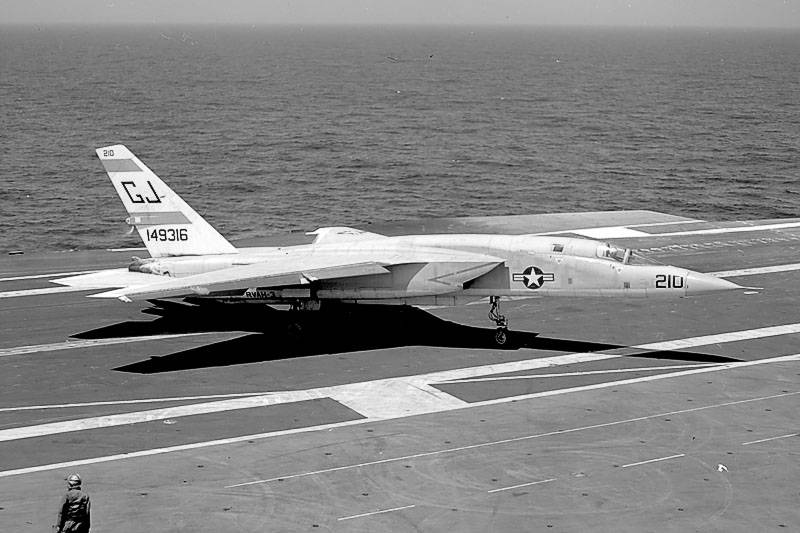
Flight data A-5 and today look very decent. The aircraft with a maximum take-off weight of 28 555 kg and a bomb load of 1820 kg had a combat radius of 2070 km. Without external suspensions at 12 km altitude, the bomber could accelerate to 2120 km / h. Widget became one of the first American serial warplanes capable of flying at supersonic speeds in cruise mode. What was provided by the two General Electric J79-GE-8 engines with nominal thrust 48,5 kN (at the oversage 75,6 kN).
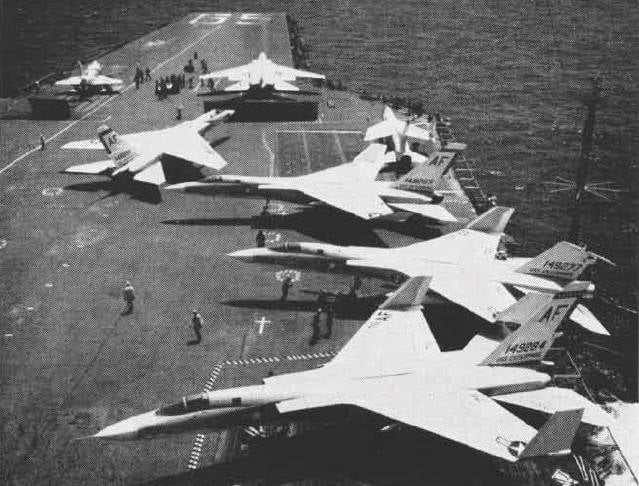
At the same time, the “widget” was very expensive to manufacture and difficult to operate by plane, which affected the number of built copies. At the start of 60, the cost of one A-5 was almost $ 10 million. At the same time, the F-4 Phantom II, which was always considered an expensive aircraft, cost the fleet $ 2 million 200 thousand. Together with pre-production prototypes at North American in Columbus was assembled 156 aircraft.
At the time of the entry of the Vigilante into service, its only task was to deliver a nuclear weapon to targets located ashore. However, simultaneously with the deliveries of A-5 to the deck aviation squadron, the deployment of a SSBN with a Polaris SLBM began, which had better combat stability and a shorter response time. As a carrier of the usual free-falling bombs, the A-6 Intruder bomber turned out to be preferable to the A-5 Vigilante in terms of cost-effectiveness.
Already in 1963, the bombers began to convert into the reconnaissance version of the RA-5C. To compensate for the losses incurred in Southeast Asia and during the flight accidents, an additional batch of reconnaissance aircraft with advanced onboard equipment was built in the 1968-1970.
The reconnaissance version differed from the bomber by a long fairing in the lower part of the fuselage, where special equipment was located: side-looking radar, electronic reconnaissance station, optical and infrared cameras. On the upgraded reconnaissance engines installed General Electric J79-10 with a brace on the afterburner 80 kN. This greatly improved the acceleration characteristics of the reconnaissance aircraft. In some cases, during reconnaissance flights over the DRV, due to the high speed of the flight, the RA-5C managed to break away from the MiGs that were pursuing them and missed with anti-aircraft missiles. In addition to high altitude and high speed, the vulnerability of the intelligence “Widget” was reduced due to the use of jamming generators and dipole reflector devices. But this did not guarantee absolute security during raids. At first, while the air defense of the DRV was based on the 37, 57, 85 and 100-mm anti-aircraft gun batteries and relatively few subsonic
MiG-17F fighters, RA-5C carrier-based reconnaissance aircraft could make their rapid reconnaissance raids with impunity. However, with the escalation of hostilities, supersonic MiG-21 fighters armed with guided missiles and incoming anti-aircraft missiles began to provide anti-aircraft defense of North Vietnam. Simultaneously with the deliveries of the MiG-21 and the SA-75М air defense missile systems on the territory of the DRV, there was a multiple increase in the radar posts, which made it possible to timely raise interceptors into the air and notify anti-aircraft calculations. According to the Vietnamese data, the DRV air defense forces managed to shoot down the 18 RA-5C. More 9 scouts were lost as a result of accidents and disasters. The "widget" was the last American combat aircraft shot down in Vietnam by the MiG-21 fighter.
After the end of the Vietnam War, the career of RA-5C was short-lived. Large, heavy and very problematic in the operation of the aircraft has become too burdensome for routine service in the composition of deck aircraft. Already in 1974, the deck shock reconnaissance squadrons disbanded and most of the RA-5C was transferred to coastal airfields. Only occasionally did these aircraft fly from aircraft carriers as part of combat training. The main "eyes" of the wings of the wing became the reconnaissance RF-4В, in many respects unified with the deck "Phantoms". In November 1979, the last RA-5C were withdrawn from the US Navy. As a result, the life of the Vigilan turned out to be significantly less than that of the Warrior, which it had to replace.
In the role of a deck bomber, the A-6 Intruder from the Grumman Corporation turned out to be much more successful. The aircraft, which entered service in the 1963 year, settled on the decks of American aircraft carriers for three and a half decades. From 1962 to 1990, the fleet received 693 "Intruder" 7 serial modifications, which also included refuelers and EW aircraft.
Over the years of operation, "Intruders" have proven to be durable, reliable and predictable in flight machines. The onboard equipment complex made it possible to carry out combat missions in any weather and at any time of the day without the need to check the airplane’s location with landmarks on the ground. The first serial modification of the Intruder at the disposal of the pilot and navigator-scorer had several radars, which were used to map the terrain, navigate and search for ground targets. All radar information was processed by the on-board computer AN / ASQ-61. The ASW-16 automatic flight control system, which stabilizes the aircraft along three axes, made it possible to fly at low altitude with a curvature of the terrain, which reduced vulnerability to air defenses. Due to the fact that the Intruder was equipped with sophisticated navigation equipment and could reach the target with high accuracy, the A-6 was often appointed as the lead groups of other strike aircraft.
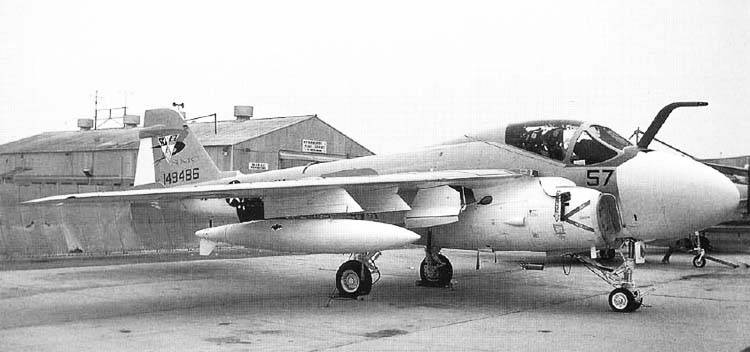
Airplanes of the first serial modification of the A-6A on five suspension nodes could carry combat loads of up to 6800 kg in the form of 227 caliber bombs — 908 kg, napalm tanks, as well as NAR and guided missiles of various purposes. On the more advanced A-6E, the maximum combat load has been increased to 8200 kg. The "intruders" of all modifications could perform bombing with high accuracy, even against targets that were not visually observed. Aircraft A-6E received a new multifunctional radar AN / APQ-148, which replaced other radio systems.
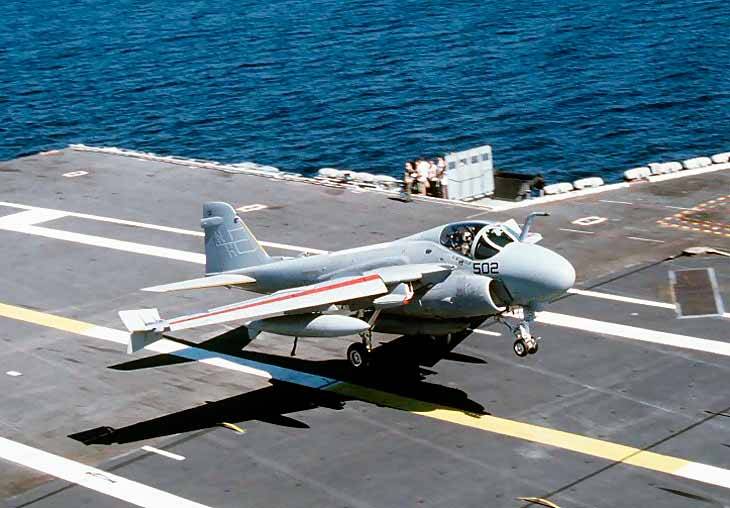
The deck bomber with a maximum takeoff weight of 27390 kg was equipped with two Pratt & Whitney J52-P8B engines with a thrust of 41 kN. When refueling 9030 liters of kerosene into the internal tanks, the combat radius was 1620 km. Ferry flight range - 5200 km. The maximum flight speed was relatively low - 1037 km / h, but the aircraft had good maneuverability. Sometimes pilots managed to dodge anti-aircraft missiles at the last moment.
The first A-6A raids took place in 1963. "Intruders" were used as part of the shock groups, and one by one. As in the case of other strike vehicles, the Navy A-6 flew from aircraft carriers, and the aircraft of the Marine Corps were based at the South Vietnamese airbases of Chu Lai and Danang. In some cases, bombers broke through to highly protected targets in difficult weather conditions or at night at extremely low altitude. In this case, the A-6 was virtually invulnerable to anti-aircraft missiles, but could even suffer from small arms fire. In total, the US Navy and USP lost the Intrudera 84 in Southeast Asia, of which 56 were hit by anti-aircraft fire, the bomber 2 became victims of MiGs, and 16 crashed for "technical" reasons. It is safe to say that among the latter were airplanes that received serious combat damage.
After the end of the Vietnamese epic A-6, unlike many other American planes, deck and tactical aircraft did not leave the scene and participated in many armed conflicts unleashed by the United States. At the beginning of December 1983, one A-6E was hit by an anti-aircraft missile over Lebanon during the bombing of Syrian positions. The pilot and navigator-bombardier ejected and were captured by Syrian soldiers. Later, the pilot died from his wounds, and the navigator was released after a month in captivity.
In April, 1986, the Intruders from the USS America and USS Coral Sea aircraft carriers, participated in Operation Eldorado Canyon. Deck bombers A-6E simultaneously with F-111, which took off from the British airbase Leikenhit, under the cover of jammers EF-111, made a raid on targets in the Benghazi area.
During the Gulf War in 1991, the A-6 of the US Navy and the Marine Corps carried out more 4700 sorties, providing direct aviation support, suppressing Iraqi enemy air defenses and destroying strategic facilities. In this case, three bomber were shot down by anti-aircraft fire.
In the first half of the 90's, the Intruders patrolled the no-fly zone in Iraq, supported the American Marines in Somalia, and bombed the Serbs in Bosnia. Although the serial production of EW EA-6B Prowler aircraft was completed in 1990, while separate elements of the airframe and wings for the upgraded A-6E were produced before 1993, the latest deck bombers went to storage at Davis-Montan already at the beginning of 1997. Official operation of tanker aircraft and jammers continued until the 2012 year. But now single instances of these machines are available at naval aviation air bases.
As can be seen from the presented review of US naval strike aircraft, designed in 50-60-ies, the US Navy had a bias towards the launch of the Vietnam War in the direction of the deck bombers. Of the jet attack aircraft, there was only a relatively light A-4 Skyhawk, which, as already mentioned, did not satisfy the admirals in range and payload. In addition, the Skyhawk security left much to be desired. The cockpit had light armor, which could not always hold rifle-caliber bullets or pieces of anti-aircraft projectiles. After the first combat missions in Southeast Asia, the command of the US Navy came to understand that the attack aircraft operating above the battlefield at low altitude should be better armored.
In 1962, Vought began designing an attack aircraft, which was to replace the Skyhawk Navy. These works began as part of a VAX competition announced by the United States Navy. Aircraft building companies also participated in the competition: Douglas Aircraft, Grumman, North American Aviation. In addition to increasing the range and payload, it was separately stipulated to increase the accuracy of bombing and the ability to operate at night and in adverse weather conditions. Most of the contestants proposed projects based on existing structures. Thus, Grumman Corporation presented a single version of the A-6 Intruder bomber, which, due to the rejection of the second crew member, significantly increased the security of the cockpit. In turn, Vought specialists presented an attack aircraft, the design of which was in many ways similar to the F-8 Crusader fighter. After reviewing the submitted projects, February 11 1964 was declared the winner by Vought. Compared to the F-8 fighter, the attack aircraft, which received the A-7 index and the corporate name Corsair II, had a shortened, extended fuselage and a reinforced wing adapted for subsonic flight speed at low altitude, in which more capacious fuel tanks were placed. To prevent an explosion in the event of a lesion, the fuel tanks were filled with neutral gas. Protection of the cabin from bullets and fragments along the sides and bottom was provided by armor elements based on boron carbide. The pilot's armored titanium armor held an 23-mm armor-piercing projectile. Aircraft control system - hydraulic, with separated wiring and triple redundancy. When placing the aircraft in the hangar of the aircraft carrier wing console folded. In contrast to the "Kruseydera" wing on the "Corsair 2" was stationary and did not change the angle of attack during takeoff and landing.
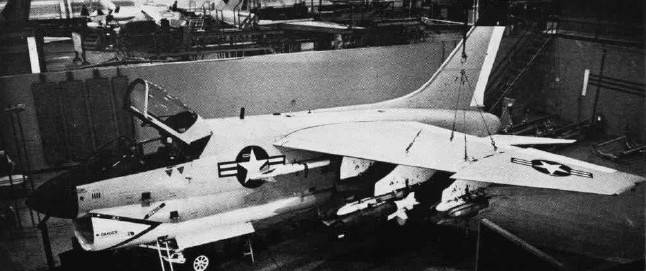
Apparently, the leadership of Vought, choosing a name for the new attack aircraft, hoped to repeat the success of the F4U Corsair piston carrier-based fighter, which was considered very successful during the Second World War and the Korean War.
Under each plane of the attack aircraft there were three weapon suspension points. Also, the A-7A inherited from the fighter side fuselage launchers to accommodate the AIM-9 Sidewinder air combat missiles. The built-in armament of the first version included two 20-mm cannon Colt Mk.12 with 250 ammunition for shells per barrel. The maximum weight of the combat load on the aircraft of the first serial modification of the A-7A was 6800 kg, which was almost twice the skyload of Skyhook. At the same time, "Corsair-2" could carry bombs weighing up to 907-kg.
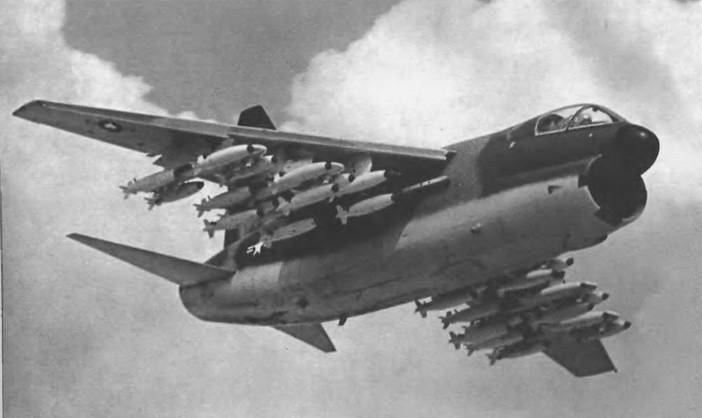
The deck A-7A attack aircraft with a maximum take-off weight of 19000 kg and fuel tanks containing 5060 liters of fuel, with the suspension of twelve 500-pound (227kg) MK.82 bombs had a combat radius of 470 km. With six 250 pounders (113 kg) Mk.81 bombs, the combat radius was 900 km. Ferry range with four PTB - 4600 km. Maximum speed without external suspensions at high altitude corresponded to 0,95 M.
In the cockpit of the deck attack aircraft A-7А the equipment was installed advanced by the standards of that time. The nose radome housed the AN / APQ-153 navigation system antennas, the AN / APQ-115 radar, which was used to map the terrain and provide low-altitude flight, as well as the AN / APQ-99 weapon radar. In addition to the radio-technical systems, the avionics included: a calculator of the weapon control system, receivers of navigation radio signals, a three-axis autopilot and an indicator with a mobile card. Antenna stations AN / APS-107 were mounted on the aircraft keel.
A powerless Pratt Whitney TF30-P-6 with a maximum load of 50,5 kN was chosen as a power plant. This two-circuit turbojet engine had good specific fuel consumption. Its forced version was originally developed for a tactical bomber with a variable geometry of the F-111A wing, and this RDDF was also installed on the F-14A deck interceptors. However, soon after the start of operation in combat units, it became clear that the reliability of the engine leaves much to be desired. Motorists did not like him because of the high complexity and capriciousness. In the case of a sharp increase in speed, the engine often “choked”.
The flight of the first prototype of the YA-7A took place on 27 September 1965 of the year. Due to the fact that the Corsair-2 had a lot in common with the serial fighter, in a year the deliveries of serial attack aircraft to the troops began. For some time, the A-7 became a lifeline for the company Vought, which could be left without orders after the serial production of the F-1965 Crusader fighter in 8 was stopped. After adopting the A-7A armament, the pace of its construction on the assembly line in Dallas amounted to 20 aircraft per month. The first carrier-based assault squadron deployed on the Cesil Field base in Florida reached combat readiness in February of the 1967 year, and in December A-7 was bombed for the first time in Vietnam.
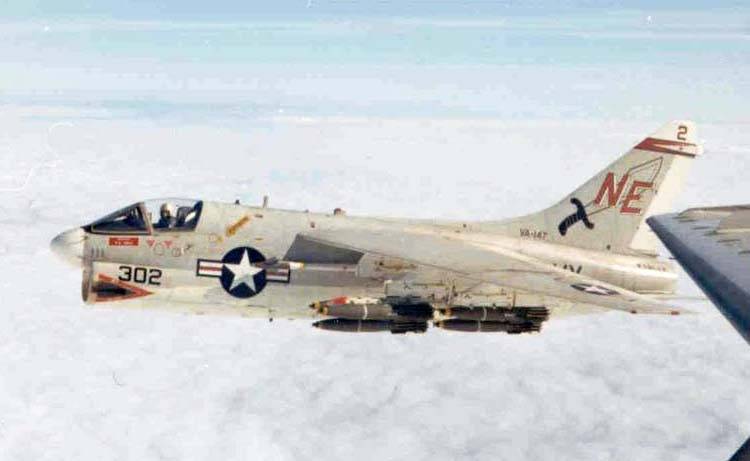
On the whole, the pilots liked the Corsair-2; in comparison with its ancestor F-8, it was an easier plane to operate. Landing on an aircraft carrier, as a rule, took place without problems. However, with a strong side wind, on the landing glide the plane became unstable. Also, the cars of the first series were often skidded on wet runways. However, it was more relevant for landings on land strips, since the aircraft carrier in the sea received planes with a head wind, and braking on the deck was performed by a cable system. The pilots noted that with a much longer range of flight and payload, the A-7 attack aircraft of the first modifications compared to the Skyhawk were sluggish, and they clearly did not have enough thrust-weight. This was especially true during takeoff with the maximum allowable weight from an aircraft carrier or ground-based GDP of limited length. The Corsair 2, loaded with bombs and tucked under the necks of the tanks, sank very heavily after launching from an aircraft carrier catapult. Documentary footage from the times of the Vietnam War has been preserved, which clearly shows that A-7A after take-off is very hard to gain altitude.
Despite the inadequate thrust-to-weight ratio and capriciousness of the engine, the Corsar-2 became one of the most effective American combat aircraft used in combat operations in Southeast Asia. The first squadron, whose December 4 aircraft dropped bombs on bridges and transport hubs of the DRV, was VA-147 from the USS Ranger (CV-61) aircraft carrier.
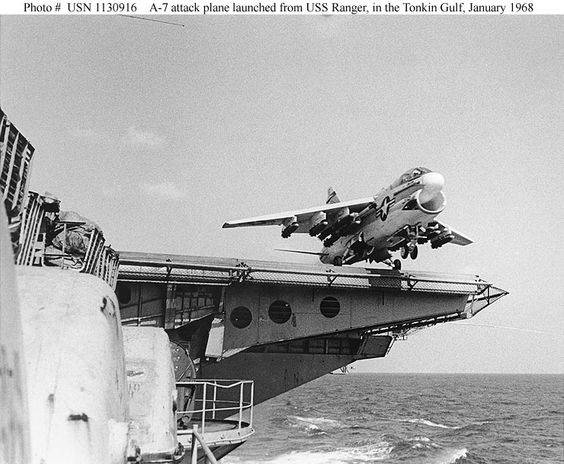
Deck ground attack aircraft A-7А, on average, carried out daily 30 sorties, during which they proved to be reliable and robust vehicles. Due to the high wing and well thought out layout, the process of suspending the armament and preparing for a re-combat sortie took about 11 hours, which was significantly less than on the F-4 fighter.
In July, the aircraft carrier Constellation (CV-1968) already arrived in the zone of military operations with two A-64A squadrons on board. From January 7 of the year, carrier-based attack aircraft of the А-1969В modification with the multifunctional AN / APQ-7 radar have connected to the air strikes on the territory of the DRV. The maintenance of the avionics of this station has improved the safety of flights in poor visibility conditions and improve the accuracy of bombing. The thrust-to-weight ratio was slightly increased by using TF116-P-30 aircraft engines with 8 kN thrust.
After the "Corsair-2" in the course of military tests in combat conditions showed good results, they became interested in the command of the Air Force. In addition to supersonic fighter-bombers, the United States Air Force required a subsonic aircraft with high fuel efficiency, adapted to provide direct air support and capable of carrying a significant combat load. The F-100 Super Saber fighter used in this role by the end of the 60-x is clearly outdated, had insufficient combat load and low resistance to combat damage.
Developed specifically for the Air Force, the A-7D was not equipped for taking off and landing on an aircraft carrier and was different from the early naval versions of the built-in six-barreled 20-mm M61 Vulcan cannon and the more reliable Allison TF41-A-1 engine with a maximum 64,5XXXXX engine with a maximum xNXXXXXX engine. is a licensed British Rolls-Royce Spey RB.168-25R. The radar AN / APN-185, as well as radar mapping of the terrain and the detection of radio-contrast targets AN / APQ-126 were introduced into the avionics avionics. The output of the most important flight information was carried out with the help of the HUD on the windshield.
The tests of the YA-7D prototype began on 6 on April 1968 of the year. The first A-7D entered service with the 57 Fighter Wing deployed at Luke Base in California and the 354 Tactical Fighter Wing at Miter Beach in South Carolina. In September 1972, two squadrons of A-7D flew from South Carolina to Korat airbase in Thailand, and were subsequently joined by attack aircraft from the 23 air force wing of the United States Air Force.
Link A-7D from the 354 th tactical fighter wing in the skies of Southeast Asia
At first, Corsair II deployed in Thailand was used to support search and rescue missions organized to evacuate downed pilots. However, soon A-7D began to be attracted to attacks on transport convoys, the destruction of bridges, crossings and warehouses, as well as to suppress air defense weapons. In 1972, X-NUMX attack aircraft A-72D operated from the territory of Thailand. By the end of the year, they completed 7 sorties, including 4087 raids into the DRV, which were considered particularly dangerous. In this case, 230 heavy 220 kg aerial bombs, 907 bombs weighing 20899 kg, 454 bombs caliber 3162-113 kg, 227 disposable bomb cassettes were spent. To suppress anti-aircraft artillery actively used airborne 463-mm guns. In total, more than 20 330 projectiles were fired toward the enemy. The weapon control system and A-000D sighting equipment ensured high precision bombing. According to official reports of the Air Force, the average deviation from the aiming point when bombing from level flight from a height of about 7 m was less than 1000 m.
The strikes were not only on the territory of the DRV and South Vietnam, in 1973, attack aircraft bombed the units of the Khmer Rouge in Cambodia. At the final stage of the hostilities, the air defense system of North Vietnam inflicted significant losses on American aircraft. In this regard, the Americans began to use the tactics of breakthroughs of single combat aircraft at low altitude at night. Over South Vietnam, Laos and Cambodia, the sorties were in most cases carried out at altitudes above 1000 m, which made it possible to avoid being hit by small arms and anti-aircraft guns. Prior to the withdrawal of US troops from Southeast Asia, according to American data, A-7D made 12928 combat missions, during which only six attack aircraft were lost - this was the best indicator among all other types of air force combat aircraft involved in the war.
In turn, the admirals, impressed by the capabilities of the modernized A-7D, demanded that Ling-Temco-Vought (LTV) bring the deck attack aircraft to the appropriate level. However, due to the shortage of Allison TF41 engines, the first A-7Cs were equipped with dual-circuit Pratt Whitney TF30-P-408, issuing 59,6 kN thrust in maximum mode. The aircraft, designed for the Navy, with the engine of increased power Allison TF41-A-2 (thrust 66,7 kN) and avionics similar to those installed on the A-7D, was designated A-7Е.
This modification subsequently became major in the US Navy. The avionics of the modernized deck attack aircraft included the AN / APQ-126 multifunctional radar with ten modes of operation, the IR station of front view (FLIR container system), the navigation and weapon control computer, Doppler navigation radar AN / APN-190, the jammer AN / ALQ-126, inertial navigation system AN / ASN-90, equipment AN / ASW-25 data lines and other equipment. Part of the aircraft was equipped with outboard containers of LANA equipment (Low Altitude Night Attack - night low-altitude combat system), which at night provided flight at altitudes up to 60 m, in semi-automatic mode following the terrain at speeds up to 740 km / h. Maximum speed without a combat load on the ground could reach 1115 km / h. In horizontal flight at an altitude of 1500 m with twelve 227 kg aerial bombs, the maximum speed was 1041 km / h.
The A-7E attack aircraft belonging to the VA-146 and VA-147 squadrons, first set off for combat missions from the USS America aircraft carrier in May 1970. As the new A-7E arrived, they replaced almost all Skyhawks by 1972. At the same time, a significant part of the A-7В attack aircraft were revised to the A-7E level. Naval pilots with flight experience on early versions of the Corsair 2 noted that due to the increased thrust-to-weight ratio and engine acceleration, the take-off process became much easier, and the payload and vertical maneuverability increased. In the last years of the Vietnam War, the Corsair 2 became a real workhorse of the assault deck squadrons. During the war, 20 assault squadrons based on 10 various aircraft carriers visited the conflict zone. In total, in the Southeast Asia, the US Navy lost 98 attack aircraft A-7 modifications: A / B / C / E. More than half of them were victims of anti-aircraft artillery, several aircraft hit anti-aircraft missiles. Unfortunately, reliable information about the participation of A-7 in aerial combat could not be found.
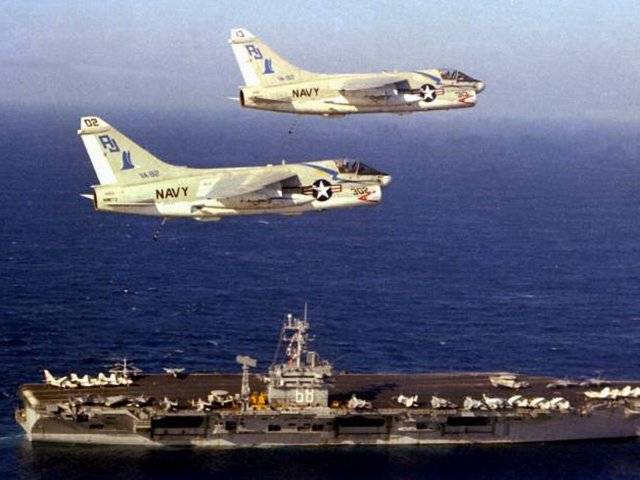
After the Vietnam War ended, the A-7 attack aircraft, along with A-6 bombers, F-4 and F-14 fighters, and also S-3 anti-submarine aircraft, settled on the decks of the US Navy aircraft carriers for a long time.
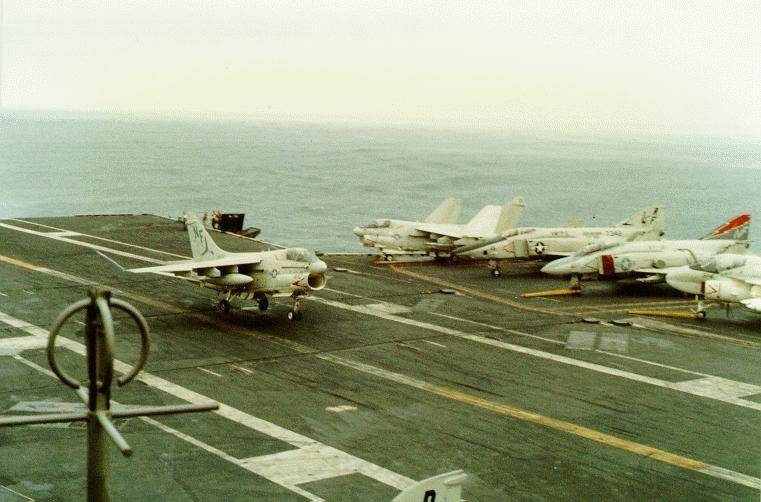
Serial construction of jet "Corsairs" lasted until the 1984 year. The aircraft was in production 19 for years. During this time, 1569 stormtroopers were handed over to the navy and air force. The cost of the new aircraft in the first half of 80-s was $ 2,6 million. For almost the entire life cycle of the attack aircraft continued to improve its combat capabilities and the creation of new special options. At the end of the 80s, the remaining Navy and National Guard Aviation A-7s were able to use virtually the entire range of American guided aviation weapons available to other deck and tactical aircraft.
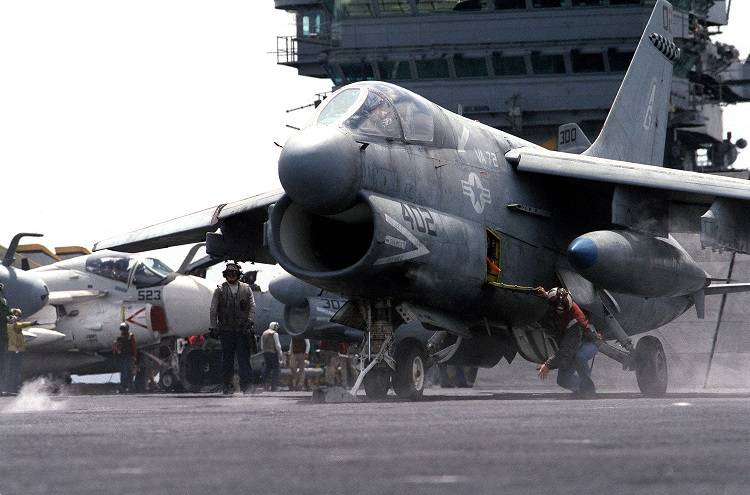
In 1976, on the order of the Navy, LTV converted the 24 A-7A and 36 A-7В into a double training variant TA-7С. In connection with the installation of the second cabin, the plane became longer by 86 centimeters. As the instructor’s seat was raised for better visibility, the aircraft acquired “humped” outlines.
In the second half of the 70-x, as the A-10A Thunderbolt II attack aircraft arrived, the air force began to transfer its A-7D to the National Guard aviation units. For the most part, these were machines with a large flight resource and in good technical condition. Moreover, in 1975-1976, the Congress allocated additional funds for the purchase of new A-7D. In 1978, LTV created a two-seat combat training variant with duplicated A-7K (TA-7D) to ensure the process of retraining and performing training flights. Between 1979 and 1980, the National Guard Aviation and Navy Training Squadrons received 30 new two-seaters. The A-7K was a full-fledged combat vehicle and could carry all types of weapons available for the A-7D. But the maximum weight of the combat load in the two-seater modification was about a ton less.
In 1984, fleet-owned 8 parks were turned into EA-7L jammers. These machines along with the ERA-3B before the start of the 90-x were used in the EQ VAQ-34 squadron, based at Point-Mugu airbase in California. The main task of the electronic warfare aircraft EA-7L and ERA-3B on the keels, which were marked with red stars, was the imitation of the enemy EW aircraft and the training of shipborne radar operators, airborne tactics and interceptor pilots.
12 January 1981 of the year 11 militants of the separatist group "Barikua Popular Army", disguised as an American military uniform, attacked the Munnis Aviation National Guard Base in Puerto Rico.
As a result of the attack on the base, the X-NUMX A-10D attack aircraft and one F-7 fighter, which was planned to be used as a monument, was blown up and damaged. The damage from the attack amounted to about $ 104 million. It was the largest single-point loss of combat aircraft since the end of the Vietnam War.
In the middle of 1981, several А-7D and А-7К were withdrawn from the National Guard Aviation and transferred to a specially formed 4451 th test squadron, where they were used to train the Invisible Pilots of the F-117 Nighthawk to the 1989 year. The home base of the dark-colored Corsairs-2 was the secret airfield of Tonopah in the state of Nevada. At the same time, the flights of attack aircraft were often of a demonstration nature, thus masking the testing process of the F-117A.
On the morning of October 20 1987 of the A-7D 4451 Squadron, during a flight from Tinker Air Base to Nevada, crashed after an engine failure, crashing into the Ramada Hotel in Indianapolis, Indiana. The pilot, who tried to divert the plane from residential buildings to the last, successfully catapulted at an altitude of 150 m, but on the ground 10 people died.
In October, the 1983 of the 28 attack aircraft A-7E from the 15 and 87 fighter-assault squadrons that make up the carrier-wing aircraft carrier of the USS Independence aircraft, during Operation Outbreak of Rage, made combat sorties, suppressing the centers of resistance on the island Gara, carrying out combat outbreaks on the island G-island, suppressing fighter forces on the island G-island, destroying resistance on the island G-island, fighting the rage, suppressing the centers of resistance on the island G-island, breaking off resistance on the island on the island G-island, breaking out the resistance on the island G-island on the island G-island. At the same time, they dropped 42 227 kg of the Mk.82 aerial bomb, 20 cluster Mk. 20 Rockeye and spent around 3000 20-mm projectiles.
In December, 1983, a group of 28 aircraft was raised from the USS Independence and USS John F Kennedy aircraft carriers. The core of the group was the A-6E bombers, they were also accompanied by 12 A-7E from VA-15 and VA-87 squadrons, which had previously taken part in the bombing of Grenada. The purpose of the deck bombers and attack aircraft was the Syrian air defense positions, command posts and ammunition depots in Lebanon. The approach of the American strike aircraft was recorded in a timely manner by Syrian radars, and air defense forces were put on alert. The Americans recognized the loss of one A-7E and one A-6E, shot down by anti-aircraft missiles over the coast of Lebanon. Another “Corsair-2” was seriously damaged as a result of a close rupture of the anti-aircraft missile warhead. The pilot was able to land on an aircraft carrier, but the aircraft was later written off.
24 March 1986, the Syrian ZRK C-200VE fired at two American F-14A Tomcat fighter aircraft. In response to the positions of the air defense missile system and the Libyan radars from the A-7E attack aircraft that took off from the deck of the USS Saratoga aircraft carrier, AGM-88 HARM anti-radar missiles were launched.
On the night of 14 on 15 in April, as part of Operation Eldorado Canyon, the Korsar-2 attack aircraft from VA-46 and VA-82, rising from the decks of USS America and USS Coral Sea, under the cover of EW EA-6 Prowler aircraft struck the positions of the Libyan air defense system and the airfield of Benghazi.
In December, 1989 of the A-7D 175 and 112 tactical fighter squadrons of the National Guard Aviation were involved in Operation Just Cause, which aimed to overthrow the Panamanian leader Manuel Noriega. The attack aircraft made 34 combat sorties after spending hours in the 72 air. The participation of A-7D in a short-term operation in Panama was the final point in the career of land "Corsairs". In the middle of 1991, all the attack aircraft of the national guards were decommissioned and stored.
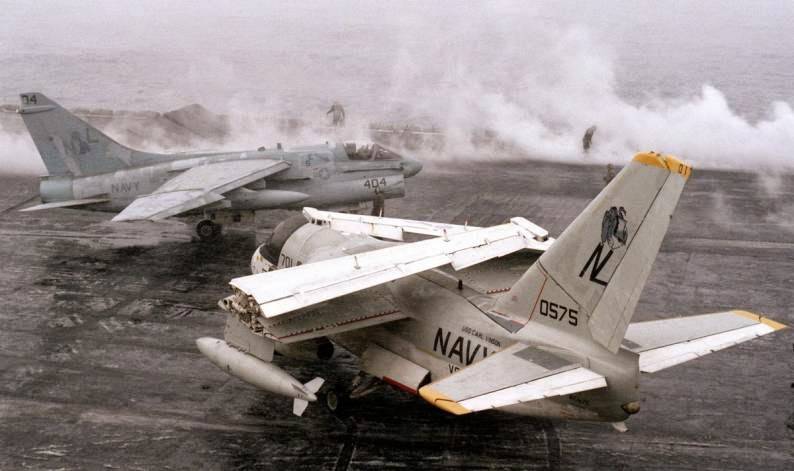
In Operation Desert Storm, the US Navy used two squadrons, VA-46 and VA-72, based on USS John F Kennedy. Initially, the A-7E pilots used the AGM-88 HARM PLR to suppress the Iraqi air defense system. Subsequently, AGM-62 Walleye II adjustable bombs and AGM-84E SLAM guided missiles were used to destroy bridges, bunkers and warehouses. During its last combat mission as part of the US Navy aviation, the Corsairs suffered no combat losses, but one plane crashed in a flight incident.
After the end of the First War in the Gulf, the deck-mounted A-7E Corsair II attack aircraft were finally crowded out by the more versatile F / A-18 Hornet fighter jets. The last flight of A-7E from the deck of an aircraft carrier took place on March 23 1991 of the year, and in May they disbanded the last two deck assault squadrons flying assault planes. Until 1994, the Corsairs were used for training purposes at the Pataxen River, Key West and Fallon air bases. After which the aircraft were deposited in Davis-Montana.
Shortly before the end of the A-7 service in the US military, LTV attempted to breathe a second life into Corsair 2. The official reason for this was a contest announced by the US Air Force to create a supersonic attack aircraft. After adopting the concept of the “Airborne Battle”, the US military, dissatisfied with the low speed of the A-10 attack aircraft, expressed a desire to get a supersonic strike aircraft capable of effectively providing direct fire support on the battlefield and hitting targets deep in the enemy’s defenses, at a distance of 100-150 km from the front line. And also act in a wide range of heights, regardless of the time of day and weather conditions. These tasks, subject to improving the avionics, were fully capable of the Warthog, but its cruising flight speed was only 560 km / h - that is, approximately at the level of World War II piston fighters. At the Pentagon, it was not without reason that the reaction time of the A-10 in the event of a collision with the forces of the Warsaw Pact in Europe would be too long, and he, despite the powerful booking, would be vulnerable to attacks by more high-speed combat aircraft and mobile air defense missiles. American generals wanted to have, albeit less protected, but more high-speed strike aircraft. To speed up the design and reduce production costs, the design of the supersonic attack aircraft should have been based on an existing type of combat aircraft.
The projects closest to the requirements of the military were those submitted by General Dynamics and Ling-Temco-Vought. The General Dynamics A-16 attack aircraft was a F-16 Fighting Falcon fighter with an armored cockpit. Due to the rejection of the radar and some reduction in maximum flight speed, it was intended to increase the security of the pilot, fuel and hydraulic systems. The variant proposed by LTV was a radically modernized A-7D. Initially, this car had the name A-7 Strikefighter, but later the designation A-7F was approved. 7 May 1987, LTV was awarded a contract to re-equip the A-7D pair to YA-7F.
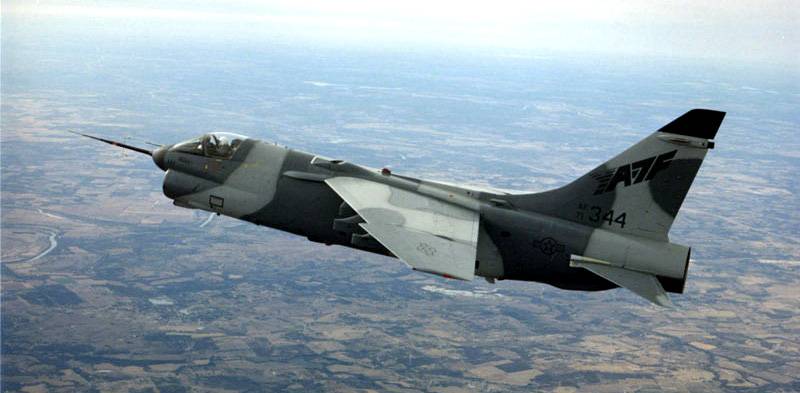
The aircraft was equipped with the Pratt Whitney F100-PW-220 TRDDF with an afterburner 120 kN. That was almost twice the maximum thrust of the Allison TF41-A-1 engine installed on the A-7D. For mounting the new engine, the fuselage was extended by 76 cm. In the root part of the reinforced wing, sags appeared, increasing stability at high angles of attack and increasing the angular speed of the turn. Thanks to the use of new flaps, the deviation of which was carried out by the commands of the automatic system, the aircraft maneuverability has improved. Keel height increased by 250 mm. In two additional fuselage compartments was placed additional avionics and fuel tank. LTV intended to upgrade to A-7F more than 300 attack aircraft, which could remain in service for 25 years. At the same time, the cost of upgrading one aircraft should not exceed $ 6,2 million, which is several times less than the cost of purchasing a new attack aircraft with similar combat capabilities.
After revision, the maximum take-off weight of the A-7F increased to 20850 kg. According to calculations, the maximum speed at the height should have been 1,2 M. The speed with combat load 7800 kg - 1080 km / h. Practical range without outboard fuel tanks - 3705 km.
YA-7F testing began in November 1989 at the US Air Force Flight Test Center at Edwards Air Base. In general, the prototypes confirmed the declared data. In addition, there was a certain reserve to improve flight performance due to the installation of an even more powerful engine. However, due to the collapse of the Eastern bloc and the reduction in defense spending in 1992, the program was closed.
The first foreign buyer of jet "Corsairs" was Greece, which ordered in the 1974 year to replace the F-84F Thunderstreak 60 fighter-bombers with the new А-7Н. This machine had a lot in common with the A-7E, but was notable for the simplified composition of the avionics and the lack of refueling equipment in the air. In 1980, the Greek Air Force received X-NUMX TA-5H sparks.
In the Greek Air Force A-7H enjoyed great popularity. Although the plane was not high-speed, the Greeks were impressed by its solid, solid construction, reliability and good payload.
At the beginning of 90, the Greek government bought for a little money another used 36 X-NUMX and X-NUMX 7. After acquiring an additional batch of attack aircraft, F-18 fighters were withdrawn from the Greek Air Force.
Some Greek attack aircraft under the curtain of his career carried a very unusual color. October 17 2014 year after 40 years of service in the Greek Air Force at Araxos Air Base held a farewell ceremony for A-7 Corsair II.
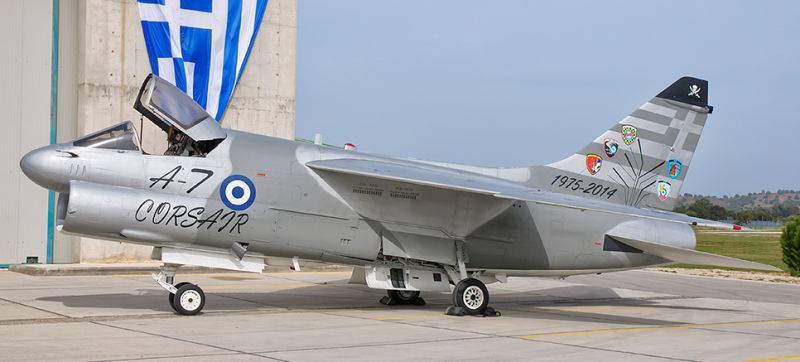
In addition to Greece, Switzerland and Pakistan showed interest in the Korsar-2 attack aircraft. However, Switzerland preferred the F-5Е / F Tiger II fighter jets, while supplies to Pakistan were blocked due to the country's implementation of a nuclear program.
In 1979, LTV was awarded a contract to upgrade the old X-NUMX attack aircraft A-20A, taken from the storage base in Davis-Montana to the A-7 level. These vehicles were purchased by Portugal to replace the F-7 Sabre fighter jets. After the restoration and modernization of the aircraft were designated A-86Р.
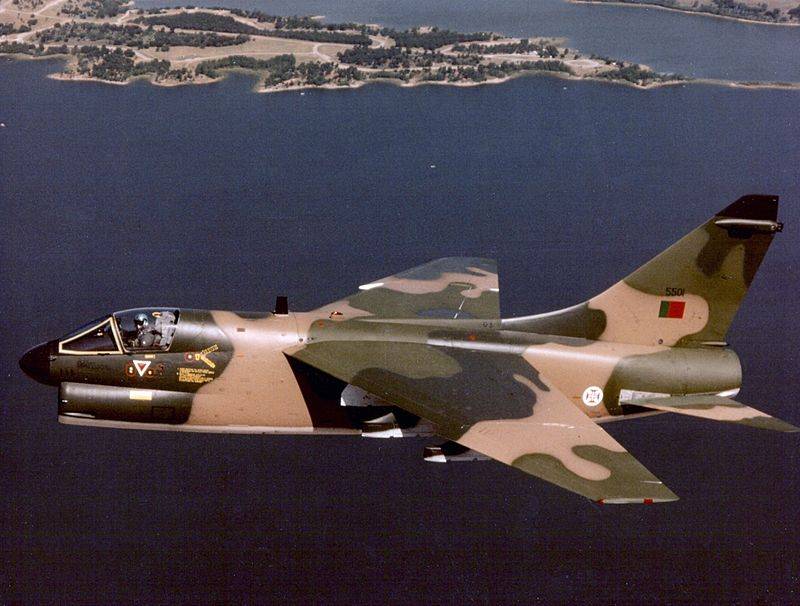
In order to provide training for pilots, the Portuguese Air Force leased one TA-7C for a period of three years. The attackers made a favorable impression, and in 1983, Portugal acquired 24 A-7Р and 6 TA-7С. As a source of spare parts in the 1986, 10 A-7А was purchased. Operation of single and double attack aircraft in Portugal ended in the year 1999.
In 1995, the Royal Thai Air Force began to develop the A-7 and TA-7C. Thailand received for a purely symbolic price 14 single attack aircraft and 4 Sparky. Before sending to the kingdom, the aircraft underwent a refurbishment at Jacksonville Air Force Base in Florida.
The aircraft were deployed at the Thai Utapao airbase and were intended primarily for air patrols. However, the intensity of A-7E flights in Thailand was very low. The planes took to the air a couple of times a week, and due to poor care they quickly came to a non-flying state. Officially, all "Corsairs-2" written off in Thailand in 2007 year.
Based on:
http://www.aircraftinformation.info/art_A7.htm
http://www.aeroflight.co.uk/types/usa/north_american/a-5/A-5.htm
http://www.alternatewars.com/SAC/A-5A_Vigilante_SAC_-_1_July_1967.pdf
https://www.globalsecurity.org/military/ops/el_dorado_canyon.htm
http://www.joebaugher.com/usattack/newa7.html
https://foxtrotalpha.jalopnik.com/the-a-7-corsair-ii-has-finally-takes-its-last-flight-af-1651178309
https://web.archive.org/web/20091027090205/http://www.geocities.com/pentagon/1979/a7dera.html
- Linnik Sergey
- Deck F-8 Crusader, its predecessors and descendants (Part of 1)
Deck F-8 Crusader, its predecessors and descendants (part of 2)
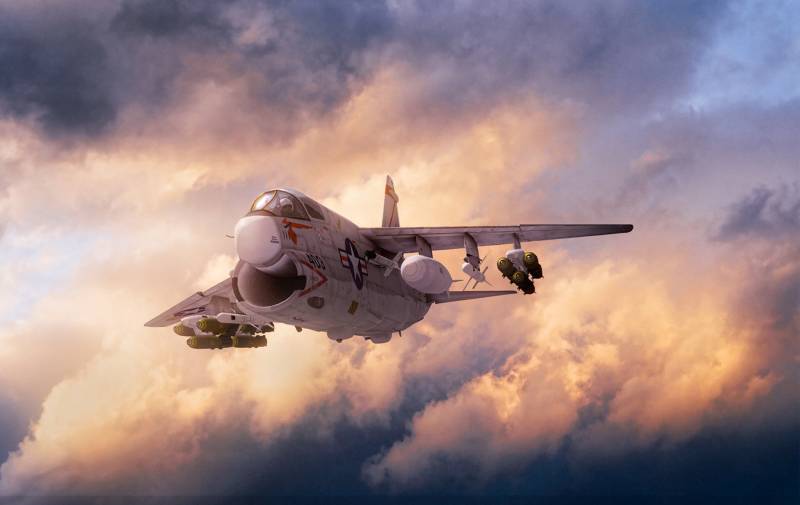
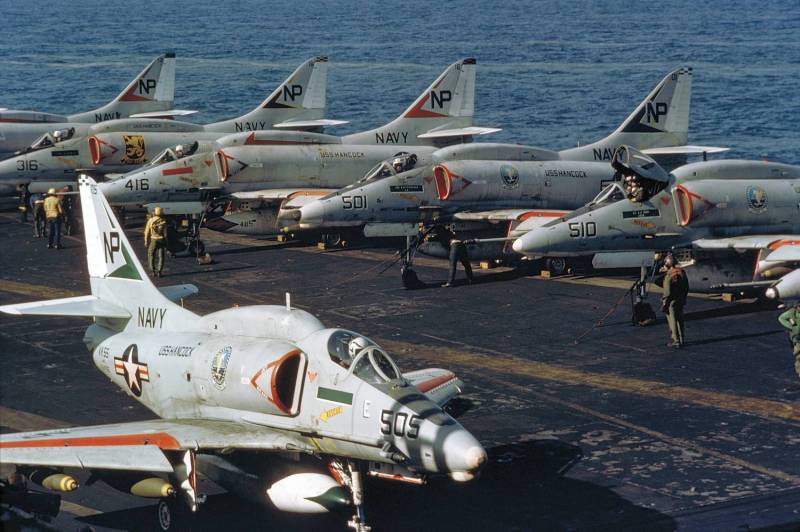
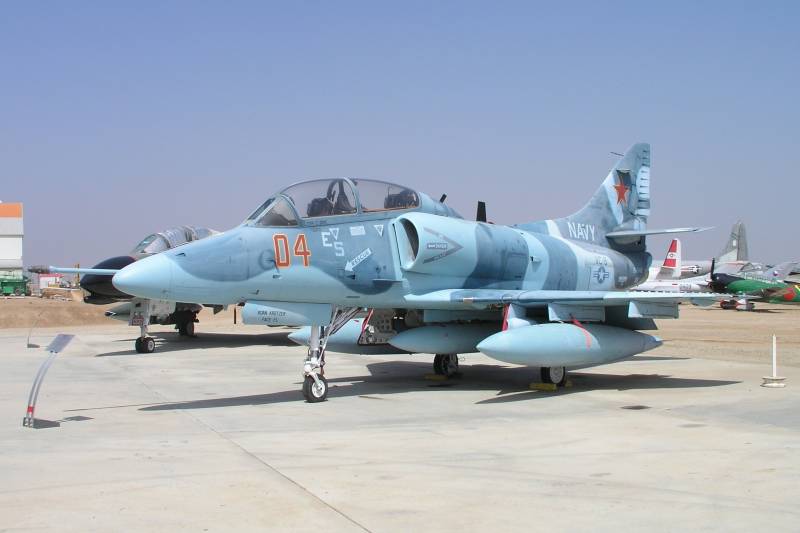
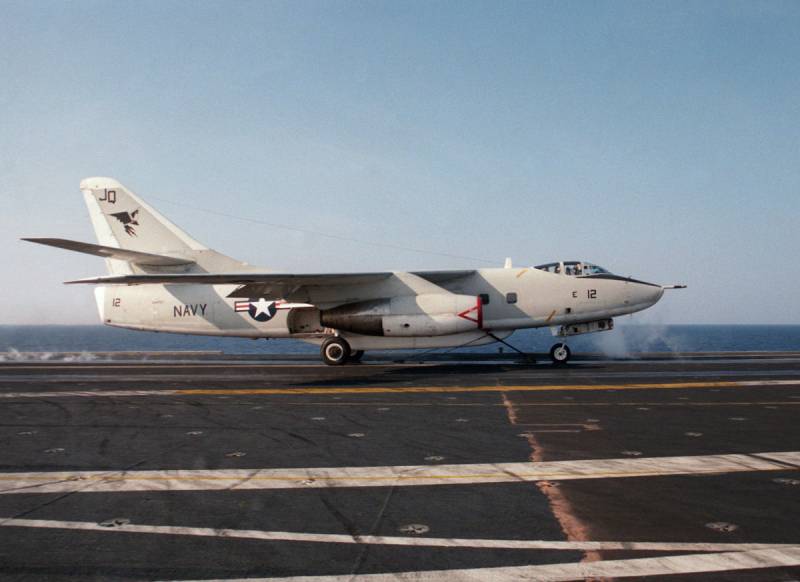
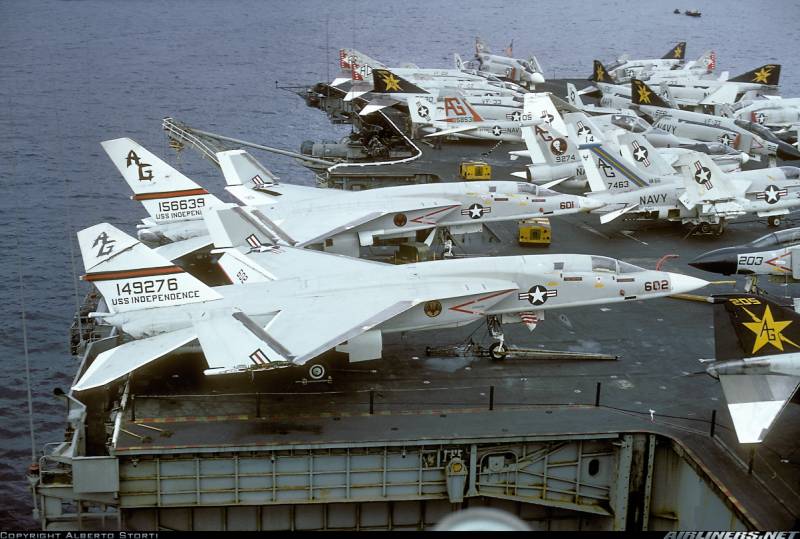
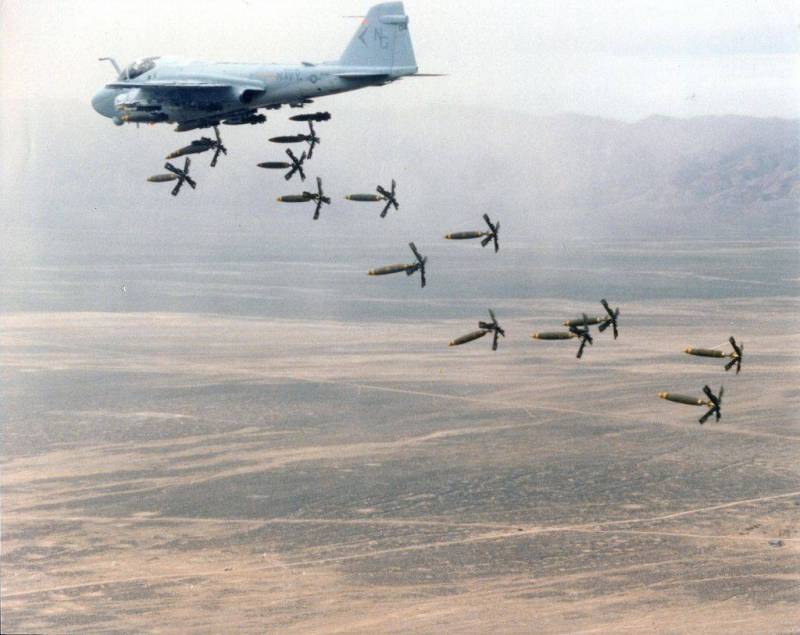
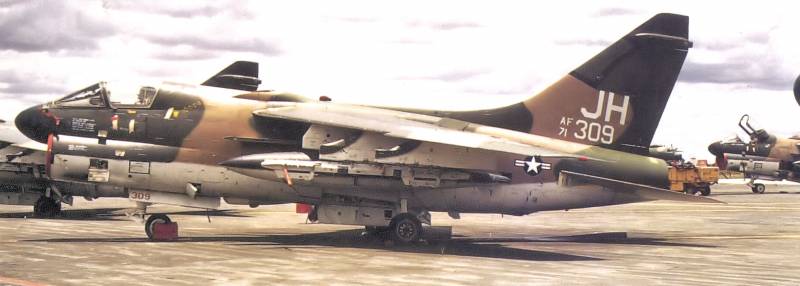
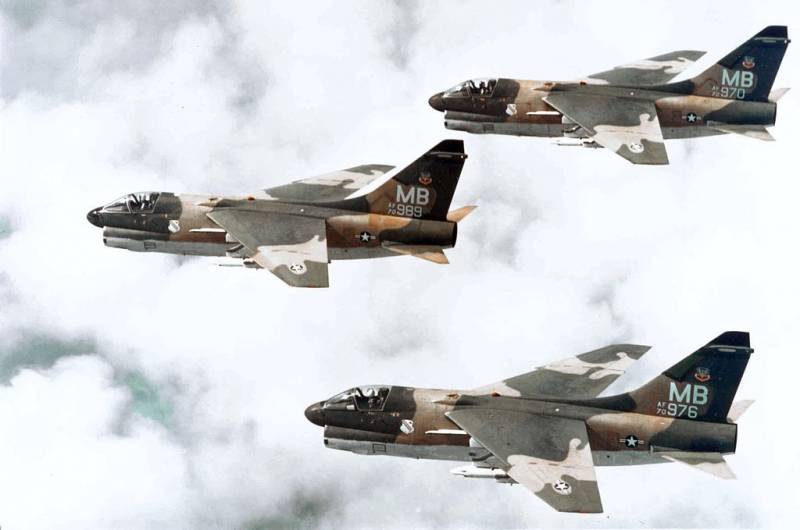
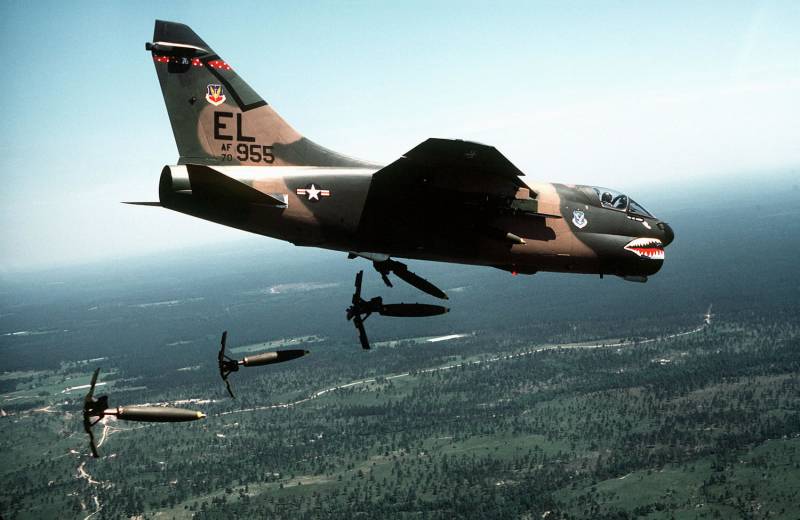
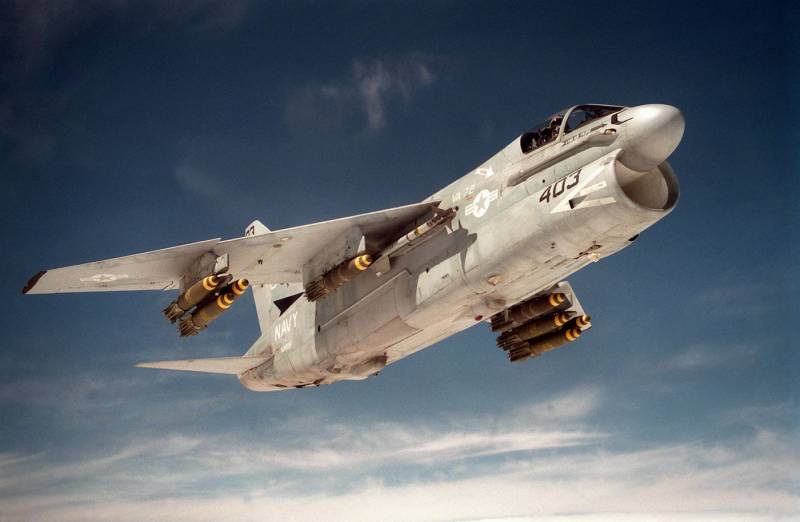
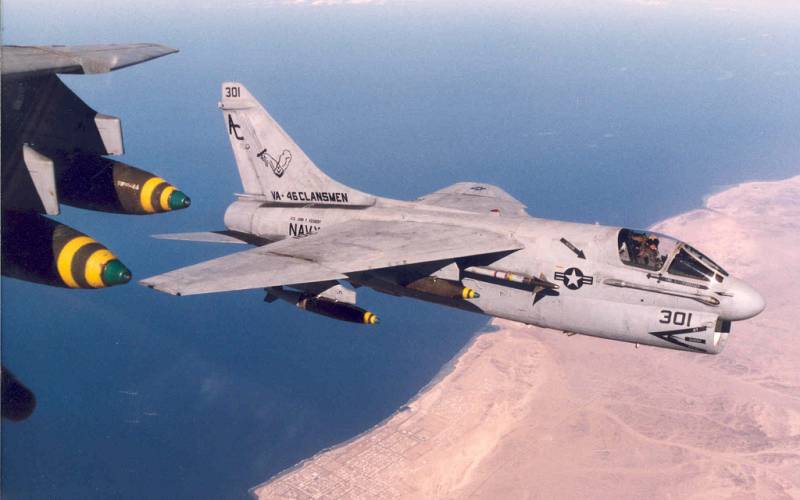
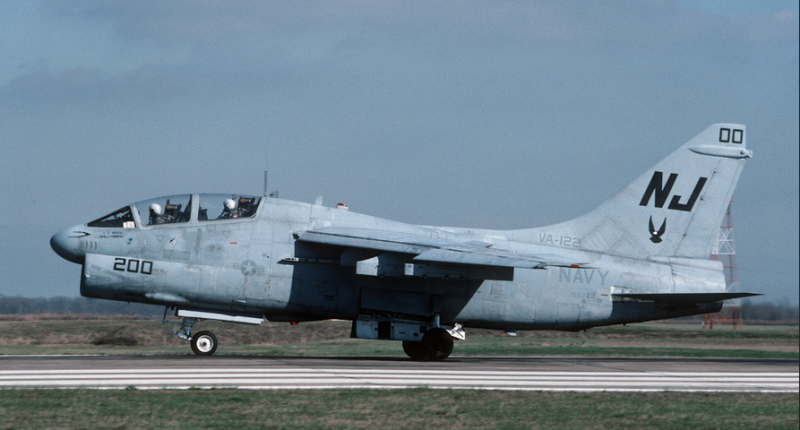
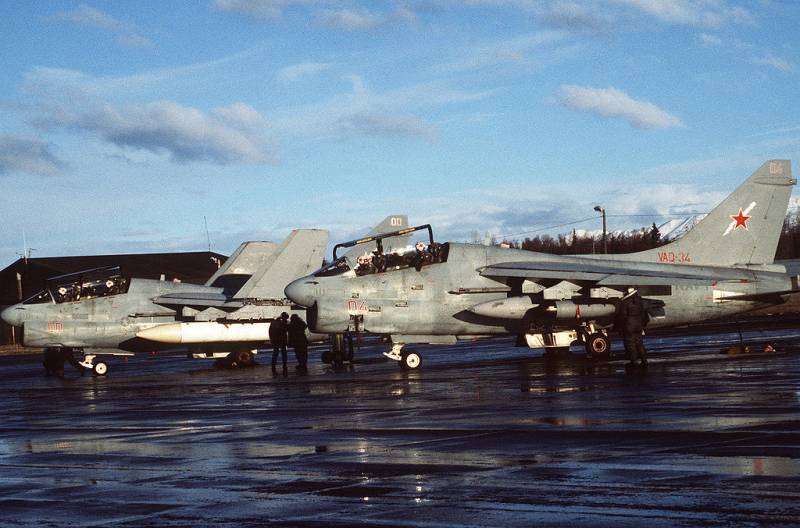
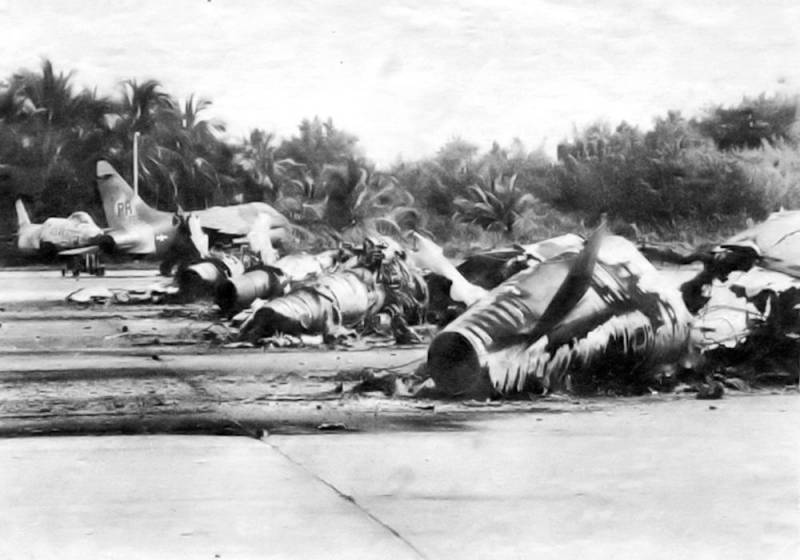
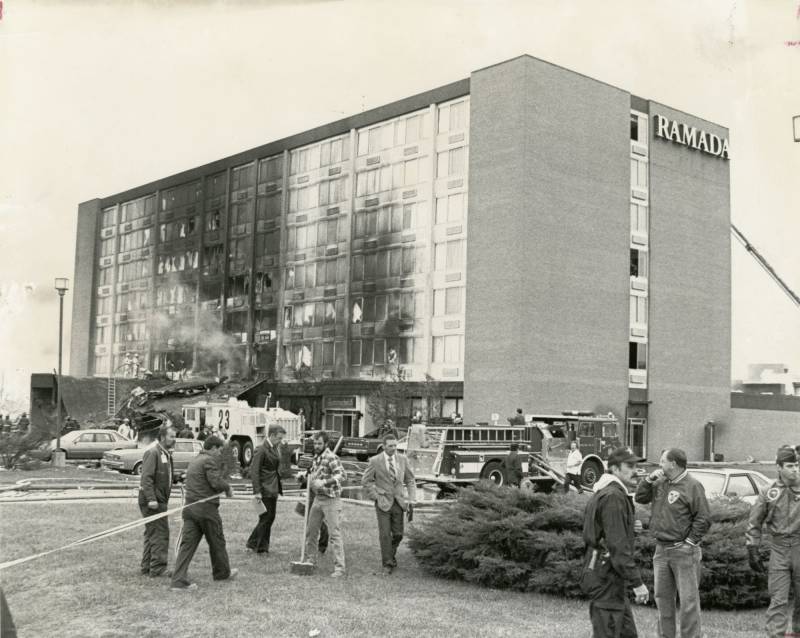
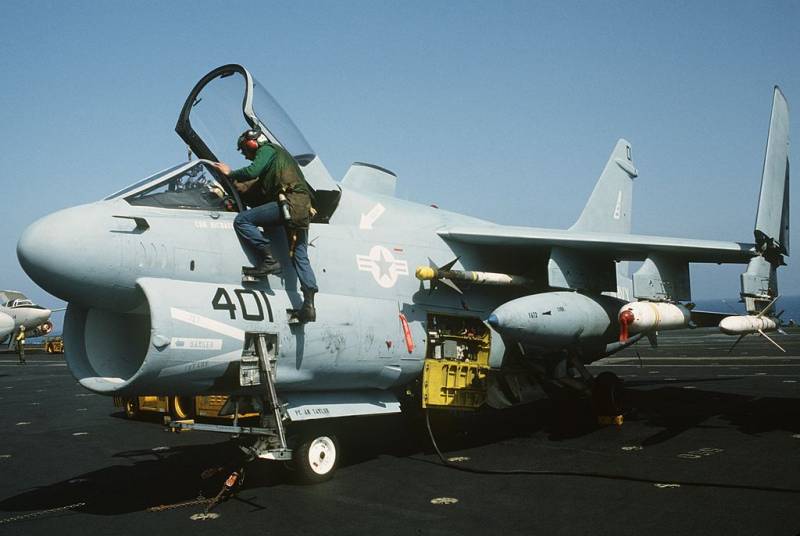
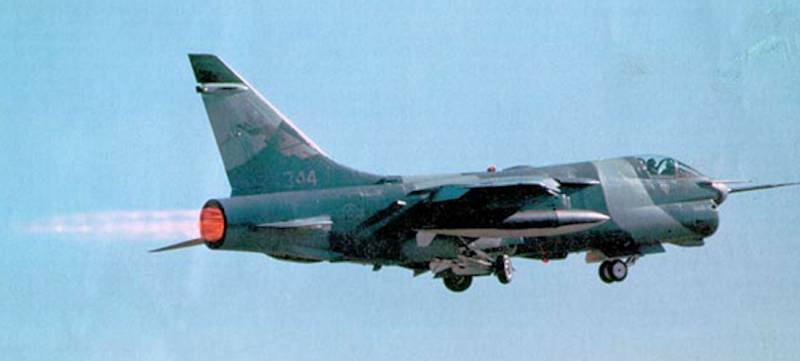
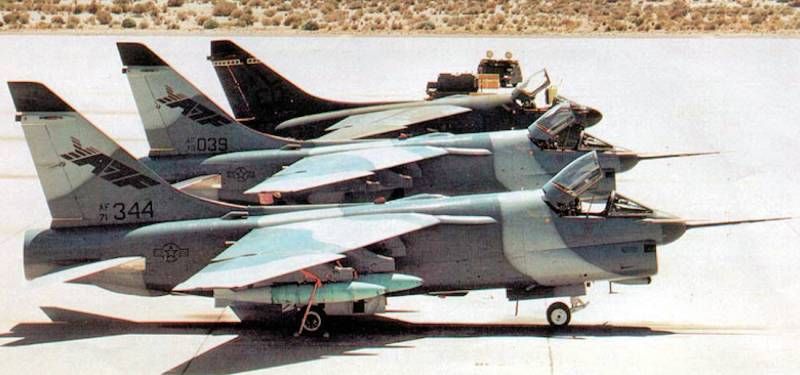
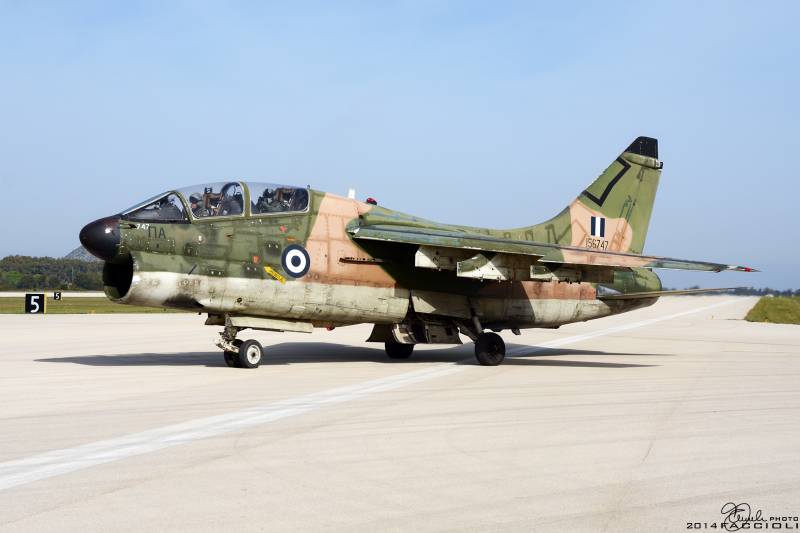
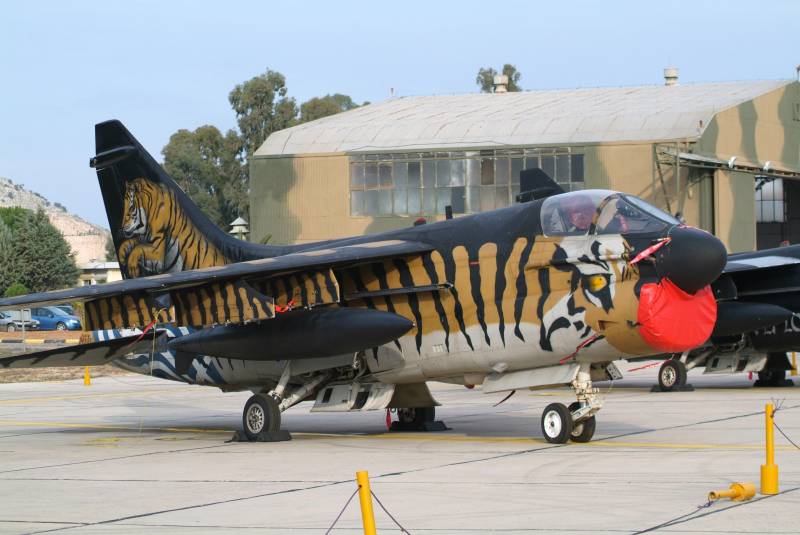
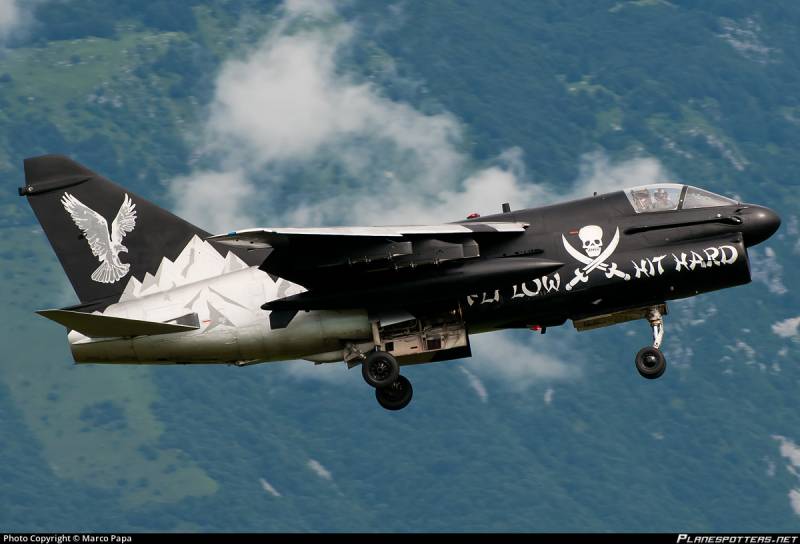
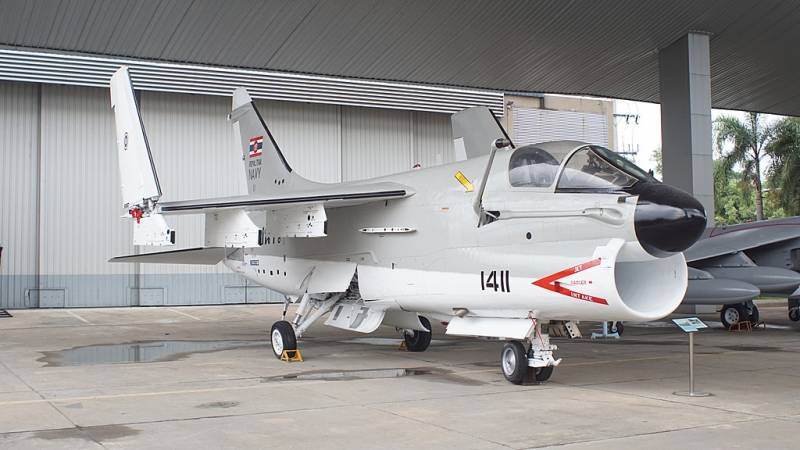
Information